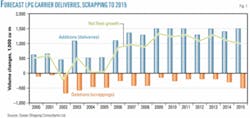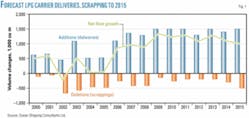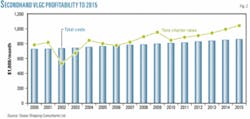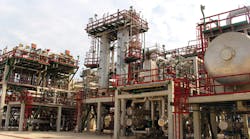The world LPG carrier fleet will expand to 24.6 million cu m by 2015 from 14.5 million cu m at the beginning of 2005, with world seaborne LPG trade (including ammonia and petrochemicals) expected to increaseto 132 million tonnes/year (tpy) from 73 million tpy during the same period, according to a new report by Ocean Shipping Consultants, “LPG Carriers: Market Prospects to 2015.”
The fleet
The world LPG fleet stood at 990 vessels at the beginning of 2005, according to OSC, dominated by the very large gas carrier (VLGC) sector, which accounts for 57% of fleet capacity. Estimated total volume was 14.5 million cu m.
By mid-2005, the LPG carrier orderbook totaled about 3.6 million cu m, equivalent to 24% of the current fleet capacity, spread over 88 vessels. South Korean shipyards dominate the LPG carrier newbuilding market with 76% of the orderbook. Japanese yards account for 17% of the newbuiliding fleet capacity.
The market
In 2004, total seaborne LPG trade was about 48 million tonnes. Transportation of ammonia accounts for about one in five cargoes carried by gas carriers, is particularly important to large gas carrier (LGC) and medium gas carrier (MGC) sectors, and accounted for about 15 million tonnes of the total.
The four main petrochemicals-ethylene, propylene, butadiene, vinyl chloride monomer-accounted for about 10 million tonnes of seaborne trade in 2004.
Freight rates, costs
Average 1-year time charter rates for VLGCs climbed to $1.1 million/month by the end of 2004 from $580,000/month in 2003. The start of 2005 was quiet, says the OSC report, but demand stayed strong and vessel availability continued to be restricted.
Newbuilding prices strengthened significantly in 2004 and have continued to rise in 2005. VLGC prices averaged more than $82 million in 2004, with reports of some vessels reaching $90 million in early 2005.
Secondhand prices based on 10-year old vessels also rose, with VLGC prices increasing to $48 million currently from the lows of $39.2 million seen in 2002.
Smaller vessels have increased even more in value in recent years.
Aggregate annual LPG carrier operating costs are about $2 million to $2.9 million across the classes, depending on vessel size.
Looking forward
OSC forecasts the LPG fleet to grow to 18.6 million cu m in 2010 and 24.6 million cu m by 2015 from 14.5 million cu m. The VLGC sector is set to witness the strongest growth, with capacity rising 82%, to more than 15 million cu m from 8.3 million cu m.
For VLGCs, says the OSC report, 1-year time charter rates will fall in the near-term but recover by 2009. There is likely to be a market correction around 2010, with the subsequent fall in rates followed by a recovery, with freight rates reaching $1 million/month by 2015.
For LGCs, says the report, 1-year time charter rates will experience a sustained increase, followed by a fall around 2010. Thereafter, rates will rise to reach $850,000/month by 2015.
For MGCs, 1-year time charter rates will follow a similar pattern as that seen in the larger vessels, with an increase in rates through 2009 followed by a decline and then sustained growth to $750,000/month by 2015.
LPG vessel operating costs will escalate, with a forecast increase of about 22% through 2010 for each of the vessel sizes, followed by an additional 19% by 2015. Broken down in absolute terms by vessel size, VLGC operating costs by 2015 will increase to $4.17 million/year, LGC costs to $3.73 million/year, and MGC costs to $3.29 million/year.
Operating profits will fluctuate with freight rates but will see a generally upward trend, with VLGC operating profits by 2015 expected to reach $700,000/month, LGC operating profits $540,000/month, and MGC $480,000/month.
Total profitability (i.e., time charter revenues less operating costs and capital costs) for a 10-year old secondhand VLGC (purchased first-quarter 2005 for $48 million) will increase to $188,000/month by 2015.
By contrast, with current freight rates declining slightly, albeit from a very high position, newbuilding vessels that have been ordered recently at record high prices will likely struggle to cover total costs after delivery. ✦



